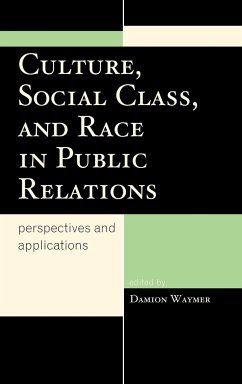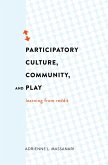Culture, Social Class, and Race in Public Relations
Perspectives and Applications
Herausgeber: Waymer, Damion
Culture, Social Class, and Race in Public Relations
Perspectives and Applications
Herausgeber: Waymer, Damion
- Gebundenes Buch
- Merkliste
- Auf die Merkliste
- Bewerten Bewerten
- Teilen
- Produkt teilen
- Produkterinnerung
- Produkterinnerung
Culture, Race, and Class-Based Perspectives in Public Relations, edited by Damion Waymer, looks at "diversity in public relations" in a novel way. Several public relations books look at gender or transnational/global PR; however, this book foregrounds issues of culture, race, and class in public relations. Some topics included are the Black Panther Party and Native American Activist rhetorical PR, risk equity, critical race theory, and pedagogical approaches to teaching culture, race, and class.
Andere Kunden interessierten sich auch für
![Culture, Communication, and Cooperation Culture, Communication, and Cooperation]() Patricia CovarrubiasCulture, Communication, and Cooperation133,99 €
Patricia CovarrubiasCulture, Communication, and Cooperation133,99 €![The Everest Effect: Nature, Culture, Ideology The Everest Effect: Nature, Culture, Ideology]() Elizabeth MazzoliniThe Everest Effect: Nature, Culture, Ideology43,99 €
Elizabeth MazzoliniThe Everest Effect: Nature, Culture, Ideology43,99 €![Culture, Communication and Cyberspace Culture, Communication and Cyberspace]() Kirk St. AmantCulture, Communication and Cyberspace206,99 €
Kirk St. AmantCulture, Communication and Cyberspace206,99 €![Culture, Space, and Power Culture, Space, and Power]() Culture, Space, and Power128,99 €
Culture, Space, and Power128,99 €![Female Business Owners in Public Relations Female Business Owners in Public Relations]() Allison WeidhaasFemale Business Owners in Public Relations121,99 €
Allison WeidhaasFemale Business Owners in Public Relations121,99 €![Participatory Culture, Community, and Play Participatory Culture, Community, and Play]() Adrienne L. MassanariParticipatory Culture, Community, and Play44,25 €
Adrienne L. MassanariParticipatory Culture, Community, and Play44,25 €![Culture, Power and Representation Culture, Power and Representation]() Sanjay AsthanaCulture, Power and Representation51,99 €
Sanjay AsthanaCulture, Power and Representation51,99 €-
-
-
Culture, Race, and Class-Based Perspectives in Public Relations, edited by Damion Waymer, looks at "diversity in public relations" in a novel way. Several public relations books look at gender or transnational/global PR; however, this book foregrounds issues of culture, race, and class in public relations. Some topics included are the Black Panther Party and Native American Activist rhetorical PR, risk equity, critical race theory, and pedagogical approaches to teaching culture, race, and class.
Hinweis: Dieser Artikel kann nur an eine deutsche Lieferadresse ausgeliefert werden.
Hinweis: Dieser Artikel kann nur an eine deutsche Lieferadresse ausgeliefert werden.
Produktdetails
- Produktdetails
- Verlag: Lexington Books
- Seitenzahl: 262
- Erscheinungstermin: 27. September 2012
- Englisch
- Abmessung: 235mm x 157mm x 20mm
- Gewicht: 581g
- ISBN-13: 9780739173404
- ISBN-10: 0739173405
- Artikelnr.: 36146911
- Herstellerkennzeichnung
- Libri GmbH
- Europaallee 1
- 36244 Bad Hersfeld
- gpsr@libri.de
- Verlag: Lexington Books
- Seitenzahl: 262
- Erscheinungstermin: 27. September 2012
- Englisch
- Abmessung: 235mm x 157mm x 20mm
- Gewicht: 581g
- ISBN-13: 9780739173404
- ISBN-10: 0739173405
- Artikelnr.: 36146911
- Herstellerkennzeichnung
- Libri GmbH
- Europaallee 1
- 36244 Bad Hersfeld
- gpsr@libri.de
Damion Waymer is assistant professor in the Department of Communication at Virginia Polytechnic Institute and State University (Virginia Tech.)
Part 1. Theoretical Discussions of Culture, Social Class, and Race in
Public Relations Chapter 1. Culture, Social Class, and Race-Based
Perspectives in Public Relations: An Introduction by Damion Waymer Chapter
2. Culture as "Traveling" Variable in Transnational Public Relations: A
Dialectical Approach by Nilanjana Bardhan Chapter 3. A City Divided:
Understanding "Class Issues" in Government Public Relations by Damion
Waymer Chapter 4. The Corporation-as-Middle-Class-Person: Corporate Social
Responsibility and Class by Josh Boyd Chapter 5. Critical Race Theory and
Public Relations by Lee Edwards Chapter 6. Two Unreconciled Strivings:
Racial Constructionism and Eliminitivism in the Philosophy of Race and its
Relevance to Public Relations by Jacoby A. Carter Part 2. Questions of
Pedagogy and Practice: Exploring Topics of Culture, Social Class, and Race
in Public Relations Education Chapter 7. Human Trafficking in the PR
Classroom: Raising Awareness for a Cause, Creating More Ethical PR
Practitioners by Sarah Hagedorn Van Slette Chapter 8. Expanding the
Spectrum of PR and Race: Lessons from European Theorists, Media Critiques,
and Catalan Programming by Jordi Xifra and David McKie Chapter 9. Higher
Learning: Rethinking Crisis Communication in Response to Racial Incidents
on Campus by Marlo Goldstein Hode and Rebecca J. Meisenbach Chapter 10.
Broaching an Uncomfortable Subject: Teaching Race in an Undergraduate
Public Relations Classroom by Damion Waymer Part 3. Culture, Social Class,
and Race in Public Relations: Applications and Implications Chapter 11.
Decolonizing Occupy Oakland: Listening for Native American Voices in a
Struggle against Social Inequality by Jackson B. Miller and Janelle Davis
Chapter 12. Speaking with and for Those Beyond the Margins: Outcast
Advocacy Relations (OAR) in Public by Damion Waymer Chapter 13. Right to
Know and Risk Communication: Implications of Risk Equity by Michael
Palenchar Chapter 14. Was Black Rhetoric Ever Anything but Race in Public
Relations? The Challenge of the Rhetoric of Identity by Robert L. Heath
Afterword by Damion Waymer
Public Relations Chapter 1. Culture, Social Class, and Race-Based
Perspectives in Public Relations: An Introduction by Damion Waymer Chapter
2. Culture as "Traveling" Variable in Transnational Public Relations: A
Dialectical Approach by Nilanjana Bardhan Chapter 3. A City Divided:
Understanding "Class Issues" in Government Public Relations by Damion
Waymer Chapter 4. The Corporation-as-Middle-Class-Person: Corporate Social
Responsibility and Class by Josh Boyd Chapter 5. Critical Race Theory and
Public Relations by Lee Edwards Chapter 6. Two Unreconciled Strivings:
Racial Constructionism and Eliminitivism in the Philosophy of Race and its
Relevance to Public Relations by Jacoby A. Carter Part 2. Questions of
Pedagogy and Practice: Exploring Topics of Culture, Social Class, and Race
in Public Relations Education Chapter 7. Human Trafficking in the PR
Classroom: Raising Awareness for a Cause, Creating More Ethical PR
Practitioners by Sarah Hagedorn Van Slette Chapter 8. Expanding the
Spectrum of PR and Race: Lessons from European Theorists, Media Critiques,
and Catalan Programming by Jordi Xifra and David McKie Chapter 9. Higher
Learning: Rethinking Crisis Communication in Response to Racial Incidents
on Campus by Marlo Goldstein Hode and Rebecca J. Meisenbach Chapter 10.
Broaching an Uncomfortable Subject: Teaching Race in an Undergraduate
Public Relations Classroom by Damion Waymer Part 3. Culture, Social Class,
and Race in Public Relations: Applications and Implications Chapter 11.
Decolonizing Occupy Oakland: Listening for Native American Voices in a
Struggle against Social Inequality by Jackson B. Miller and Janelle Davis
Chapter 12. Speaking with and for Those Beyond the Margins: Outcast
Advocacy Relations (OAR) in Public by Damion Waymer Chapter 13. Right to
Know and Risk Communication: Implications of Risk Equity by Michael
Palenchar Chapter 14. Was Black Rhetoric Ever Anything but Race in Public
Relations? The Challenge of the Rhetoric of Identity by Robert L. Heath
Afterword by Damion Waymer
Part 1. Theoretical Discussions of Culture, Social Class, and Race in
Public Relations Chapter 1. Culture, Social Class, and Race-Based
Perspectives in Public Relations: An Introduction by Damion Waymer Chapter
2. Culture as "Traveling" Variable in Transnational Public Relations: A
Dialectical Approach by Nilanjana Bardhan Chapter 3. A City Divided:
Understanding "Class Issues" in Government Public Relations by Damion
Waymer Chapter 4. The Corporation-as-Middle-Class-Person: Corporate Social
Responsibility and Class by Josh Boyd Chapter 5. Critical Race Theory and
Public Relations by Lee Edwards Chapter 6. Two Unreconciled Strivings:
Racial Constructionism and Eliminitivism in the Philosophy of Race and its
Relevance to Public Relations by Jacoby A. Carter Part 2. Questions of
Pedagogy and Practice: Exploring Topics of Culture, Social Class, and Race
in Public Relations Education Chapter 7. Human Trafficking in the PR
Classroom: Raising Awareness for a Cause, Creating More Ethical PR
Practitioners by Sarah Hagedorn Van Slette Chapter 8. Expanding the
Spectrum of PR and Race: Lessons from European Theorists, Media Critiques,
and Catalan Programming by Jordi Xifra and David McKie Chapter 9. Higher
Learning: Rethinking Crisis Communication in Response to Racial Incidents
on Campus by Marlo Goldstein Hode and Rebecca J. Meisenbach Chapter 10.
Broaching an Uncomfortable Subject: Teaching Race in an Undergraduate
Public Relations Classroom by Damion Waymer Part 3. Culture, Social Class,
and Race in Public Relations: Applications and Implications Chapter 11.
Decolonizing Occupy Oakland: Listening for Native American Voices in a
Struggle against Social Inequality by Jackson B. Miller and Janelle Davis
Chapter 12. Speaking with and for Those Beyond the Margins: Outcast
Advocacy Relations (OAR) in Public by Damion Waymer Chapter 13. Right to
Know and Risk Communication: Implications of Risk Equity by Michael
Palenchar Chapter 14. Was Black Rhetoric Ever Anything but Race in Public
Relations? The Challenge of the Rhetoric of Identity by Robert L. Heath
Afterword by Damion Waymer
Public Relations Chapter 1. Culture, Social Class, and Race-Based
Perspectives in Public Relations: An Introduction by Damion Waymer Chapter
2. Culture as "Traveling" Variable in Transnational Public Relations: A
Dialectical Approach by Nilanjana Bardhan Chapter 3. A City Divided:
Understanding "Class Issues" in Government Public Relations by Damion
Waymer Chapter 4. The Corporation-as-Middle-Class-Person: Corporate Social
Responsibility and Class by Josh Boyd Chapter 5. Critical Race Theory and
Public Relations by Lee Edwards Chapter 6. Two Unreconciled Strivings:
Racial Constructionism and Eliminitivism in the Philosophy of Race and its
Relevance to Public Relations by Jacoby A. Carter Part 2. Questions of
Pedagogy and Practice: Exploring Topics of Culture, Social Class, and Race
in Public Relations Education Chapter 7. Human Trafficking in the PR
Classroom: Raising Awareness for a Cause, Creating More Ethical PR
Practitioners by Sarah Hagedorn Van Slette Chapter 8. Expanding the
Spectrum of PR and Race: Lessons from European Theorists, Media Critiques,
and Catalan Programming by Jordi Xifra and David McKie Chapter 9. Higher
Learning: Rethinking Crisis Communication in Response to Racial Incidents
on Campus by Marlo Goldstein Hode and Rebecca J. Meisenbach Chapter 10.
Broaching an Uncomfortable Subject: Teaching Race in an Undergraduate
Public Relations Classroom by Damion Waymer Part 3. Culture, Social Class,
and Race in Public Relations: Applications and Implications Chapter 11.
Decolonizing Occupy Oakland: Listening for Native American Voices in a
Struggle against Social Inequality by Jackson B. Miller and Janelle Davis
Chapter 12. Speaking with and for Those Beyond the Margins: Outcast
Advocacy Relations (OAR) in Public by Damion Waymer Chapter 13. Right to
Know and Risk Communication: Implications of Risk Equity by Michael
Palenchar Chapter 14. Was Black Rhetoric Ever Anything but Race in Public
Relations? The Challenge of the Rhetoric of Identity by Robert L. Heath
Afterword by Damion Waymer








